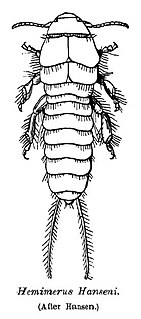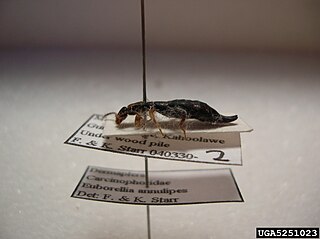
Cerci are paired appendages on the rear-most segments of many arthropods, including insects and symphylans. Many forms of cerci serve as sensory organs, but some serve as pinching weapons or as organs of copulation. In many insects, they simply may be functionless vestigial structures.

Arixenia esau is a species of earwig, one of three species in the genus Arixenia.
Xeniaria jacobsoni is a species of earwigs, in the genus Xeniaria, family Arixeniidae, the suborder Arixeniina, and the order Dermaptera. It is one of three genera in the genus Xeniaria.
Xeniaria truncata is a species of earwigs, in the genus Xeniaria, family Arixeniidae, the suborder Arixeniina, and the order Dermaptera. It is one of three genera in the genus Xeniaria.

Hemimeridae is a family of earwigs, the only family in the suborder Hemimerina, one of the four suborders in the order Dermaptera. The other three suborders are Archidermaptera, which is extinct, Arixeniina, and Forficulina, the largest of the four. Hemimeridae is represented by two genera, Hemimerus and Araeomerus. They are wingless, blind and viviparous ectoparasites of African rodents, and have filiform segmented cerci. The best known species is Hemimerus bouvieri. Hemimeridae contains eleven described species placed within two genera: Hemimerus and Araeomerus. Hemimerids are relatively small (5–15 mm) and inhabit the fur of giant murid rats in Africa. Hemimerids have short, broad legs with grooves that allow them to cling to the host and specialized mouthparts for scraping dead skin and fungus from their host. Araeomerus is found in the nest of long-tailed pouch rats (Beamys) and Hemimerus is found on giant (Cricetomys) rats. Araeomerus are found more often in the burrows and nests of Beamys rat than on the rat itself, while Hemimerus less frequently leaves its host.

Hemimerus is a genus of earwigs, in the family Hemimeridae. It one of two genera in the family Hemimeridae, and contains ten species:
Asiodiplatys speciousus is an extinct species of earwig in the family Protodiplatyidae. It is the only species in the genus Asiodiplatys. It had long and thin cerci that were very different from modern species of Dermaptera, but tegmina and hind wings that folded up into a "wing package" that are like modern earwigs. Like Archidermapteron martynovi, the only clear fossil of the species was found in Russia.

Anisolabididae is a family of earwigs, in the suborder Forficulina and the order Dermaptera. It is one of nine families in the suborder Forficulina, and contains thirty-eight genera spread across thirteen subfamilies.
The 2009 Big 12 Conference football season was the 14th season for the Big 12, as part of the 2009 NCAA Division I FBS football season.
The 2010 national road cycling championships began in January in Australia and New Zealand. Most of the European national championships take place in June.
Puteri Indonesia 2010, the 15th Annual Puteri Indonesia beauty pageant, was held in Jakarta Convention Center, Jakarta, Indonesia on October 8, 2010. Thirty eight contestants from all 33 provinces of Indonesia competed for the title of Puteri Indonesia, one of the most prominent beauty pageant titles in the country. Qory Sandioriva, Puteri Indonesia 2009 from Aceh crowned her successor Nadine Alexandra Dewi Ames of Jakarta SCR 4 at Assembly Hall, Jakarta Convention Center, Jakarta. Ames is going to represent Indonesia at the Miss Universe 2011 in São Paulo, Brazil, while the first and second runners-up will represent the nation at the Miss International 2011 and the Miss Asia Pacific World 2011 respectively.
Araeomerus morrisi is a species of earwig, in the genus Araeomerus, family Hemimeridae, suborder Hemimerina.
The 2010–11 Liga IV was the fourth level of the Romanian football league system. It was disputed in each of the 41 counties of Romania and in the municipality of Bucharest. The winner of each series has to play a promotion playoff against a neighbouring county to gain promotion to Liga III.
The 2011–12 USHL season is the 32nd season of the United States Hockey League as an all-junior league. The regular season began on September 30, 2011 and concluded on April 14, 2012 with the regular season champion winning the Anderson Cup.






